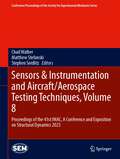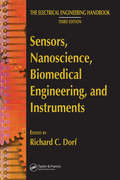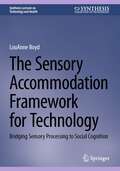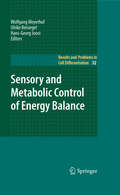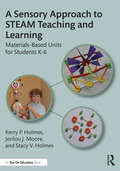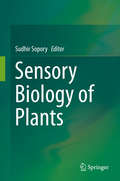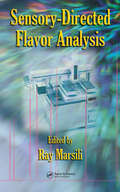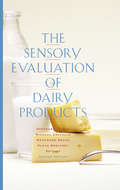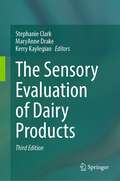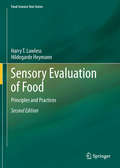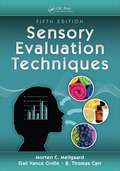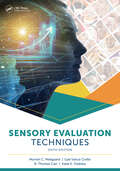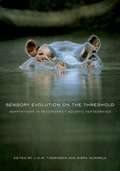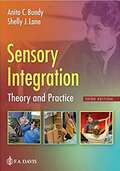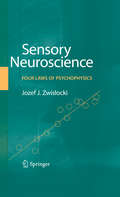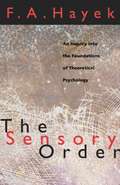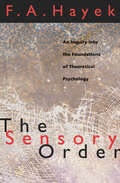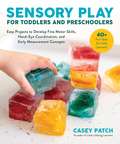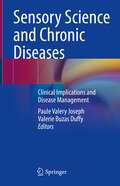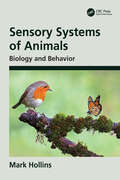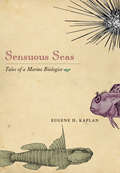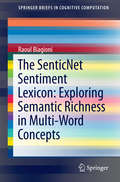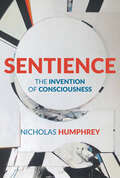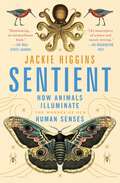- Table View
- List View
Sensors & Instrumentation and Aircraft/Aerospace Testing Techniques, Volume 8: Proceedings of the 41st IMAC, A Conference and Exposition on Structural Dynamics 2023 (Conference Proceedings of the Society for Experimental Mechanics Series)
by Chad Walber Matthew Stefanski Stephen SeidlitzSensors & Instrumentation and Aircraft/Aerospace Testing Techniques, Volume 8: Proceedings of the 41st IMAC, A Conference and Exposition on Structural Dynamics, 2023, the eighth volume of ten from the Conference brings together contributions to this important area of research and engineering. The collection presents early findings and case studies on fundamental and applied aspects of Shock & Vibration, Aircraft/Aerospace Testing Techniques including papers on:Alternative Sensing & AcquisitionActive ControlsInstrumentation
Sensors, Nanoscience, Biomedical Engineering, and Instruments: Sensors Nanoscience Biomedical Engineering (The Electrical Engineering Handbook)
by Richard C. DorfIn two editions spanning more than a decade, The Electrical Engineering Handbook stands as the definitive reference to the multidisciplinary field of electrical engineering. Our knowledge continues to grow, and so does the Handbook. For the third edition, it has expanded into a set of six books carefully focused on a specialized area or field of study. Each book represents a concise yet definitive collection of key concepts, models, and equations in its respective domain, thoughtfully gathered for convenient access.Sensors, Nanoscience, Biomedical Engineering, and Instruments provides thorough coverage of sensors, materials and nanoscience, instruments and measurements, and biomedical systems and devices, including all of the basic information required to thoroughly understand each area. It explores the emerging fields of sensors, nanotechnologies, and biological effects. Each article includes defining terms, references, and sources of further information. Encompassing the work of the world’s foremost experts in their respective specialties, Sensors, Nanoscience, Biomedical Engineering, and Instruments features the latest developments, the broadest scope of coverage, and new material on multisensor data fusion and MEMS and NEMS.
The Sensory Accommodation Framework for Technology: Bridging Sensory Processing to Social Cognition (Synthesis Lectures on Technology and Health)
by LouAnne BoydThis book provides a thorough introduction to the many facets of designing technologies for autism, with a particular focus on optimizing visual attention frameworks. This book is designed to provide a detailed overview of several aspects of technology for autism. Each Chapter illustrates different parts of the Sensory Accommodation Framework and provides examples of relevant available technologies. The books first discusses a variety of skills that make up human development as well as a history of autism as a diagnosis and the birth of the neurodiversity movement. It goes on to detail individual types of therapy and how they interact with autism. The systems involved in sensory processing and their specific relation to autism are then explored, including through technologies that have addressed these areas and applications for designers. Readers will learn about designing sensory environments and sensory interactions, such as through virtual reality. This book places a needed emphasis on the hierarchy of information in technology development by exploring visual attention in neurodivergent conditions like autism, ADHD, and dyslexia. It also delves into the relationship between sensory perception and nonverbal communication, the bridge between sensory input and social behavior, and dynamic information. The discussion is rounded out with examinations of temporal processing as and multisensory integration as complicating factors that have existing technological solutions. Finally, the book closes with a summary of the sensory accommodation framework in respect to how each layer offers different user experience goals and specific mechanisms to promote those goals. Readers from a variety of research backgrounds will find this book informative and useful, while designers will learn essential skills for effectively designing autism technologies.
Sensory and Metabolic Control of Energy Balance
by Wolfgang Meyerhof Ulrike Beisiegel Hans-Georg JoostThe prevalence of obesity has dramatically increased in western and westernized societies, making the disease the second leading cause of unnecessary deaths in the US. Obesity results from imbalanced metabolic regulation leading to excessive lipid storage. As important novel entities in metabolic regulation, taste receptors and their cells are critical elements that adapt the gustatory system to metabolic signals and vice versa. The role of taste receptor genes in gastrointestinal tissues, as well as their dynamic regulation in gustatory and non-gustatory tissues in response to metabolic cues, has become the focus of an entirely new and rapidly developing research field with impacts on fuel sensing, metabolic control, and ingestive behavior. This book reflects the recent scientific progress in the field of fuel sensing in the mouth, GI tract, and brain and examines the olfactory bulb as a potential metabolic sensor and the brain-gut endocrine axis. It also touches on relevant novel molecular and cellular mechanisms regulating lipid storage and metabolism and covers the identification and functional characterization of obesity genes. Lastly, it illustrates the use of insect models to study relevant problems of energy homeostasis.
A Sensory Approach to STEAM Teaching and Learning: Materials-Based Units for Students K-6
by Kerry P. Holmes Jerilou J. Moore Stacy V. HolmesDid you know you have the power and the materials at your fingertips to facilitate the actual brain growth of students? This book is a practical resource to engage K-6 students with STEAM content through their five senses: seeing, listening, touch/movement, smell and taste. It combines historical research, practical suggestions, and current practices on the stages of cognitive development and the brain’s physical response to emotion and novelty; to help you learn ways to transform ordinary lesson plans into novel and exciting opportunities for students to learn through instruction, exploration, inquiry, and discovery. In addition to providing examples of sensory-rich unit plans, the authors take you through the step-by-step process on how to plan a thematic unit and break it down into daily seamless lesson plans that integrate science, technology, engineering, arts, and mathematics. With 25 themed STEAM unit plans and activities based on national standards, up-to-date research on brain science, and real classroom experience, this book shows multiple ways to develop and deliver active multisensory activities and wow your students with sights and sounds as soon as they come through the door of your classroom.
A Sensory Approach to STEAM Teaching and Learning: Materials-Based Units for Students K-6
by Kerry P. Holmes Jerilou J. Moore Stacy V. HolmesDid you know you have the power and the materials at your fingertips to facilitate the actual brain growth of students?This book is a practical resource to engage K-6 students with STEAM content through their five senses: seeing, listening, touch/movement, smell and taste. It combines historical research, practical suggestions, and current practices on the stages of cognitive development and the brain’s physical response to emotion and novelty; to help you learn ways to transform ordinary lesson plans into novel and exciting opportunities for students to learn through instruction, exploration, inquiry, and discovery.In addition to providing examples of sensory-rich unit plans, the authors take you through the step-by-step process on how to plan a thematic unit and break it down into daily seamless lesson plans that integrate science, technology, engineering, arts, and mathematics.With 25 themed STEAM unit plans and activities based on national standards, up-to-date research on brain science, and real classroom experience, this book shows multiple ways to develop and deliver active multisensory activities and wow your students with sights and sounds as soon as they come through the door of your classroom.
Sensory Biology of Plants
by Sudhir SoporyPlants provide a source of survival for all life on this planet. They are able to capture solar energy and convert it into food, feed, wood and medicines. Though sessile in nature, over many millions of years, plants have diversified and evolved from lower to higher life forms, spreading from sea level to mountains, and adapting to different ecozones. They have learnt to cope with challenging environmental conditions and various abiotic and biotic factors. Plants have also developed systems for monitoring the changing environment and efficiently utilizing resources for growth, flowering and reproduction, as well as mechanisms to counter the impact of pests and diseases and to communicate with other biological systems, like microbes and insects. This book discusses the “awareness” of plants and their ability to gather information through the perception of environmental cues, such as light, gravity, water, nutrients, touch and sound, and stresses. It also explores plants’ biochemical and molecular “computing” of the information to adjust their physiology and development to the advantage of the species. Further, it examines how plants communicate between their different organs and with other organisms, as well as the concepts of plant cognition, experience and memory, from both scientific and philosophical perspectives. Lastly, it addresses the phenomenon of death in plants.The epilogue presents an artist’s view of the beauty of the natural world, especially plant “architecture”. The book provides historical perspectives, comparisons with animal systems where needed, and general biochemical and molecular concepts and themes. Each chapter is selfcontained, but also includes cross talk with other chapters to offer an integrated view of plant life and allow readers to appreciate and admire the functioning of plant life from within and without. The book is a tribute by the Editor to his students, colleagues and co-workers and to those in whose labs he has worked.
Sensory-Directed Flavor Analysis
by Ray MarsiliToday, flavor chemists can generate copious amounts of data in a short time with relatively little effort using automated solid phase micro-extraction, Gerstel-Twister and other extraction techniques in combination with gas chromatographic (GC) analysis. However, more data does not necessarily mean better understanding. In fact, the ability to extr
The Sensory Evaluation of Dairy Products
by Stephanie Clark Floyd Bodyfelt Maryanne Drake Michael CostelloThe Sensory Evaluation of Dairy Products, Second Edition is for all who seek a book entirely devoted to sensory evaluation of dairy products and modern applications of the science. It is an excellent scientific reference for training in dairy product evaluation and is a practical guide to the preparation of samples for sensory evaluation. The book contains updates of the original text of the well-received first edition, as well as brand new material. This unique book is designed for professionals involved in many aspects of dairy production, including academic teaching and research, processing, quality assurance, product development and marketing. It is an invaluable tool for those who compete in the annual Collegiate Dairy Product Evaluation Contest.
The Sensory Evaluation of Dairy Products
by Stephanie Clark MaryAnne Drake Kerry KaylegianThe Sensory Evaluation of Dairy Products, Third Edition is for all who seek a book entirely devoted to sensory evaluation of dairy products and modern applications of the science. It is an excellent scientific reference for training in dairy product evaluation and is a practical guide to the preparation of samples for sensory evaluation. The book contains updates of the original text of the well-received first edition, as well as brand new material. This unique book is designed for professionals involved in many aspects of dairy production, including academic teaching and research, processing, quality assurance, product development and marketing. It is an invaluable tool for those who compete in the annual Collegiate Dairy Product Evaluation Contest.
Sensory Evaluation of Food
by Hildegarde Heymann Harry T. LawlessThis volume covers all the basic techniques of sensory testing, from simple discrimination tests to home use placements for consumers. It provides fundamental theories, psychological and statistical, that form the basis and rationale for sensory test design. Statistics used in sensory evaluation are also demonstrated both as stand-alone material presented in appendices and as integrated applications in the context of appropriate sensory methods. Chapters are constructed so that beginning students who want only the practical aspects of conducting sensory test will see clear instruction on how test should be conducted. Advanced students and practitioners will enjoy the more detailed sections on rationale and related issues.
Sensory Evaluation Techniques
by Gail Vance Civille B. Thomas CarrThis new edition of a bestseller covers all phases of performing sensory evaluation studies, from listing the steps involved in a sensory evaluation project to presenting advanced statistical methods. Like its predecessors, Sensory Evaluation Techniques, Fifth Edition gives a clear and concise presentation of practical solutions, accepted methods,
Sensory Evaluation Techniques
by Gail Vance Civille B. Thomas Carr Katie E. OsdobaThe sixth edition of this classic text brings sensory evaluation to life for new students and experienced professionals alike. A full array of sensory methods is covered – including descriptive techniques, discrimination testing, and consumer research, plus guidance on test design, statistical analysis, and how to translate results into insights for actionable decisions. Like its predecessors, Sensory Evaluation Techniques, Sixth Edition gives a clear and concise presentation of practical solutions, accepted methods, and standard practices, in addition to advanced techniques.What’s new in the sixth edition: An expanded chapter on Sensory Physiology, including recent research on individual differences in perception A thorough discussion of Thurstonian theory and its application to discrimination methods, including the Tetrad Test New sections on technology in sensory evaluation, including a discussion of software options for data collection Improved & updated case studies to aid learning comprehension Updated appendices for Spectrum Method attributes, references, and scales Updated references Online supplemental content Sensory Evaluation Techniques remains a practical, relevant, and flexible resource, providing how-to information for a wide variety of users in industry, government, and academia who need the most current information to conduct effective sensory research. It also supplies students with the necessary theoretical background in sensory evaluation methods, applications, and interpretations.
Sensory Evolution on the Threshold: Adaptations in Secondarily Aquatic Vertebrates
by J. G. M. Thewissen Sirpa NummelaThis synthesis explores the function and evolution of sensory systems in animals whose ancestors lived on land. Together, the contributors explore the dramatic transformation of smell, taste, sight, hearing, balance, mechanoreception, magnetoreception, and electroreception that occurred as lineages of amphibians, reptiles, birds, and mammals returned to aquatic environments.
Sensory Integration: Theory and Practice
by Anita C. Bundy Shelly J Lane“Perfect just what I needed for a course and it'sa great book[.] Would recommend to any Occupational therapist, speech, or physical therapist interested in working with the sensory population”—Alexandra A. <p><p> “This is a wonderful resource book for Occupational Therapists working with children. It is clear and easy reading for new and old therapists.”—Denise M. <p><p> “… written to enlarge existing understanding of sensory integration without intimidating the reader. The wealth of knowledge can help not only the new graduate, but also the more experienced practitioner.”—Mrs. Consuello M. <p><p> Drs. Bundy and Lane, with their team of contributing experts and scholars, provide guidance and detailed case examples of assessment and intervention based in sensory integration theory. They describe the neurophysiological underpinnings and synthesize current research supporting the theory and intervention.
Sensory Neuroscience: Four Laws of Psychophysics
by Jozef J. ZwislockiSensory Neuroscience: Four Laws of Psychophysics organizes part of psychophysics -- a science of quantitative relationships between human sensations and the stimuli that evoke them. Although psychophysics belongs to sensory neuroscience, and is coupled to neurophysiology, it has also branched out to various specialized disciplines, including the disciplines of vision and hearing, ophthalmology, optometry, otology, and audiology. Due to this diversification and fragmentation, psychophysics has had an ad-hoc, phenomenological orientation. Besides Weber's law of differential sensitivity, and the still-controversial Stevens' power law, it has lacked a systematic grid of scientific laws. Sensory Neuroscience: Four Laws of Psychophysics provides valid unifying principles and systematic applications for this otherwise fragmented precursor of experimental psychology, and defines four multisensory relationships of substantial generality between sensations and the underlying stimulus variables. This book will be particularly useful to auditory researchers, experimental psychologists, and behavioral neuroscientists.
The Sensory Order
by F. A. HayekThe Sensory Order, first published in 1952, sets forth F. A. Hayek's classic theory of mind in which he describes the mental mechanism that classifies perceptions that cannot be accounted for by physical laws. Hayek's substantial contribution to theoretical psychology has been addressed in the work of Thomas Szasz, Gerald Edelman, and Joaquin Fuster. "A most encouraging example of a sustained attempt to bring together information, inference, and hypothesis in the several fields of biology, psychology, and philosophy."--Quarterly Review of Biology F. A. Hayek (1899-1992), recipient of the Medal of Freedom in 1991 and co-winner of the Nobel Memorial Prize in Economics in 1974, taught at the University of London, the University of Chicago, and the University of Freiburg.
The Sensory Order: An Inquiry into the Foundations of Theoretical Psychology
by F. A. HayekThe Nobel Prize-winning economist explores how the mind works—an early landmark in the field of cognitive science. The Sensory Order, first published in 1952, sets forth F. A. Hayek's classic theory of mind in which he describes the mental mechanism that classifies perceptions that cannot be accounted for by physical laws. Though Hayek is more commonly known as an icon in the field of economics, his genius was wide-ranging—and his contribution to theoretical psychology is of continuing significance to cognitive scientists as well as to economists interested in the interplay between psychology and market systems, and has been addressed in the work of Thomas Szasz, Gerald Edelman, and Joaquin Fuster. &“A most encouraging example of a sustained attempt to bring together information, inference, and hypothesis in the several fields of biology, psychology, and philosophy.&”—Quarterly Review of Biology
Sensory Play for Toddlers and Preschoolers: Easy Projects to Develop Fine Motor Skills, Hand-Eye Coordination, and Early Measurement Concepts
by Casey PatchExplore taste-safe small worlds, create colorful pieces of art, and engage all five senses while investigating the great outdoors. Sensory play is a wonderful way to explore the world with your little learners!Sensory Play for Toddlers and Preschoolers is a practical, hands-on guide for parents and educators who want to inject more play into their children's day! Since this collection features simple sensory play ideas with items you already have in your home, playtime has never been easier. Inside the book, you&’ll find forty easy sensory play tubs and activities with extra bonus ideas for extending the activities even further! Not only will your child be learning and exploring through play, but you&’ll also be creating some magical memories of playtime that will last a lifetime! Learn how to get started with sensory play using tips, tricks, and sensory play staples.Follow quick and easy, tried and tested sensory base recipes designed to ignite the senses and inspire hours of sometimes messy, always memorable playtime.Create thoughtful sensory invitations and artworks while developing fine motor skills, hand-eye coordination, early measurement concepts and so much more! Sensory play allows our little learners to make connections as they explore the world around them using their senses of sight, smell, taste, sound, and touch. It&’s the beginning of a lifelong journey of scientific understanding and a wonderful way to connect and bond with your little learners! Projects include: Rainbow RiceCloud DoughSand FoamEdible MudWater TubRainbow SpaghettiFrozen Building BlocksOutdoor KitchenJell-O Bug RescueBubble Wrap Paintingsand more!
Sensory Science and Chronic Diseases: Clinical Implications and Disease Management
by Paule Valery Joseph Valerie Buzas DuffyThe textbook provides an overview of the sensory science field in the context of diseases such as obesity and Coronavirus disease 2019 (COVID-19). This book brings a summary of the state of the science in key areas and provides examples of translational science from using cellular and rodent models to human clinical trials and community health. The volume structure leads the reader through the physiology of taste and smell into how sensory testing for taste and smell is studied, basic mechanisms, various protocols that are used throughout the field along with the pros/cons of the current methods used. This resource is intended for classroom teaching, for novice researchers in sensory research as well as students and postdoctoral fellows. Example of courses are nutrition, basic nursing, interdisciplinary health courses, sensory perception (psychology), neuroscience, and medical courses, dentistry, food science and others.
Sensory Systems of Animals: Biology and Behavior
by Mark HollinsPerception in animals is a fascinating and challenging subject that calls to students from many disciplines. The aim of this book is to provide a knowledge base and unifying perspective on the field that will enable beginning researchers to chart their own course within it. The author describes, in a systematic but engaging way, the sensory systems of humans and other vertebrates, as well as arthropods and molluscs.Why is it important to understand the senses of animals? One reason is that human activities are changing the perceptual world of animals in ways that expose them to danger. From bright outdoor lighting disorienting migrating birds to human sonar driving whales to beach themselves; it is becoming increasingly important to find ways to reduce such dangers. This will require big changes in human behavior, and greater understanding of how animals react, physiologically and behaviorally, to anthropogenic changes in their environment.The emphasis throughout is on research, in both the behavioral/ethological and neuroscientific traditions, that has led to important discoveries. The functional anatomy of each system, from receptor cells to brain areas, is succinctly described, explaining how it underlies the animal’s sensory abilities and behavior. Overall descriptions of a sense for a class of animals (for example, hearing in arachnids) are interspersed with expanded coverage of that sense in a particular animal, such as the ogre-faced web-casting spider that does a backflip to capture an insect buzzing overhead. Evolutionary themes are found throughout the book, for example in describing the development of the vertebrate ear, and in the convergent evolution of the eyes of vertebrates and cephalopods.With over 500 references and 80 illustrations, this textbook is intended as primary reading for advanced undergraduates and beginning graduate students of biology, neuroscience, sensory psychology, and veterinary science. It will also be of interest to professionals and academics in these fields, and to anyone else who works with or studies animals.
Sensuous Seas: Tales of a Marine Biologist
by Eugene H. KaplanLearning marine biology from a textbook is one thing. But take readers to the bottom of the sea in a submarine to discover living fossils or to coral reefs to observe a day in the life of an octopus, and the sea and its splendors come into focus, in brilliant colors and with immediacy. In Sensuous Seas, Eugene Kaplan offers readers an irresistibly irreverent voyage to the world of sea creatures, with a look at their habitats, their beauty and, yes, even their sex lives. A marine biologist who has built fish farms in Africa and established a marine laboratory in Jamaica, Kaplan takes us to oceans across the world to experience the lives of their inhabitants, from the horribly grotesque to the exquisitely beautiful. In chapters with titles such as "Fiddler on the Root" (reproductive rituals of fiddler crabs) and "Size Does Count" (why barnacles have the largest penis, comparatively, in the animal kingdom), Kaplan ventures inside coral reefs to study mating parrotfish; dives 740 feet in a submarine to find living fossils; explains what results from swallowing a piece of living octopus tentacle; and describes a shark attack on a friend. The book is a sensuous blend of sparkling prose and 150 beautiful illustrations that clarify the science. Each chapter opens with an exciting personal anecdote that leads into the scientific exploration of a distinct inhabitant of the sea world--allowing the reader to experience firsthand the incredible complexity of sea life. A one-of-a-kind memoir that unfolds in remarkable reaches of ocean few of us can ever visit for ourselves, Sensuous Seas brings the underwater world back to living room and classroom alike. Readers will be surprised at how much marine biology they have learned while being amused.
The SenticNet Sentiment Lexicon: Exploring Semantic Richness in Multi-Word Concepts
by Raoul BiagioniThe research and its outcomes presented in this book, is about lexicon-based sentiment analysis. It uses single-, and multi-word concepts from the SenticNet sentiment lexicon as the source of sentiment information for the purpose of sentiment classification. In 6 chapters the book sheds light on the comparison of sentiment classification accuracy between single-word and multi-word concepts, for which a bespoke sentiment analysis system developed by the author was used. This book will be of interest to students, educators and researchers in the field of Sentic Computing.
Sentience: The Invention of Consciousness
by Nicholas HumphreyThe story of a quest to uncover the evolutionary history of consciousness from one of the world's leading theoretical psychologists.We feel, therefore we are. Conscious sensations ground our sense of self. They are crucial to our idea of ourselves as psychic beings: present, existent, and mattering. But is it only humans who feel this way? Do other animals? Will future machines? Weaving together intellectual adventure and cutting-edge science, Nicholas Humphrey describes in Sentience his quest for answers: from his discovery of blindsight in monkeys and his pioneering work on social intelligence to breakthroughs in the philosophy of mind.The goal is to solve the hard problem: to explain the wondrous, eerie fact of &“phenomenal consciousness&”—the redness of a poppy, the sweetness of honey, the pain of a bee sting. What does this magical dimension of experience amount to? What is it for? And why has it evolved? Humphrey presents here his new solution. He proposes that phenomenal consciousness, far from being primitive, is a relatively late and sophisticated evolutionary development. The implications for the existence of sentience in nonhuman animals are startling and provocative.
Sentient: How Animals Illuminate the Wonder of Our Human Senses
by Jackie HigginsPerfect for fans of The Soul of an Octopus and The Genius of Birds, this &“revelatory book&” (Sy Montgomery, New York Times bestselling author) explores how we process the world around us through the lens of the incredible sensory capabilities of thirteen animals, revealing that we are not limited to merely five senses.There is a scientific revolution stirring in the field of human perception. Research has shown that the extraordinary sensory powers of our animal friends can help us better understand the same powers that lie dormant within us. From the harlequin mantis shrimp with its ability to see a vast range of colors, to the bloodhound and its hundreds of millions of scent receptors; from the orb-weaving spider whose eyes recognize not only space but time, to the cheetah whose ears are responsible for its perfect agility, these astonishing animals hold the key to better understanding how we make sense of the world around us. &“An appealingly written, enlightening, and sometimes eerie journey into the extraordinary possibilities for the human senses&” (Kirkus Reviews, starred), Sentient will change the way you look at humanity.
